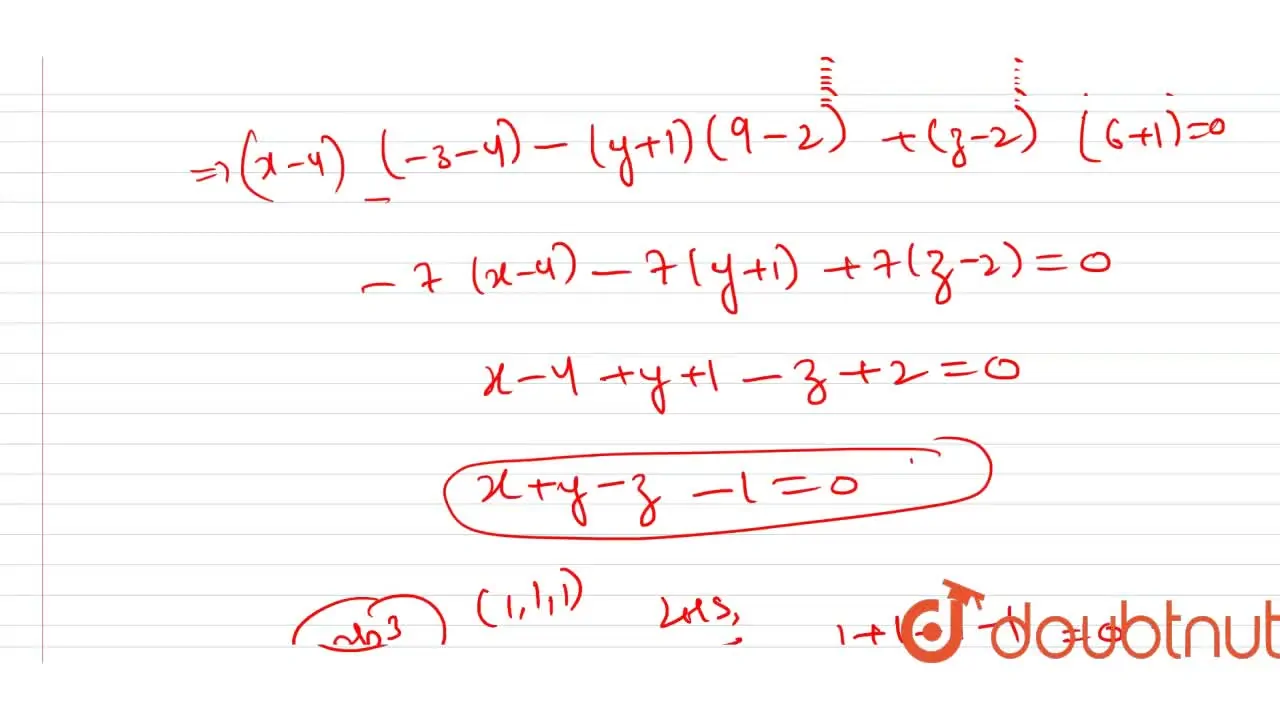The plane passing through the point (4, -1, 2) and perallel to the lines and also passes through the point
(-1, -1, -1)
(1, 1, -1)
(1, 1, 1)
(-1, -1, 1)
The correct Answer is:C
Let a be the position vector of the given point (4,-1,2).
Then,
The direction vector of the lines
and
are respectively
and
Now, as the plane is parallel to both and
[ plane is parallel to the given lines]
So, normal vector (n) of the plane is perpendicular to both and .
and
Required equation of plane is
(1, 1, 1) is the only point that satisfies.
Related Playlists
- BOOK - IIT JEE PREVIOUS YEARCHAPTER - 3D GeometryEXERCISE - Equation of Plane Objective Question II (One or more than pne correct option)5videos
3D Geometry
- BOOK - IIT JEE PREVIOUS YEARCHAPTER - 3D GeometryEXERCISE - Equation of Plane Objective Question II (Numerical Value)1videos
3D Geometry
- BOOK - IIT JEE PREVIOUS YEARCHAPTER - 3D GeometryEXERCISE - Straight Line in Space and Shortest Distance Objective Question II (One or more than one correct option)3videos
3D Geometry
- BOOK - IIT JEE PREVIOUS YEARCHAPTER - PROPERTIES OF TRIANGLESEXERCISE - CIRCUMCIRCLE, INCIRCLE, ESCRIBED CIRCLE, ORTHOCENTRE,INCENTRE AND CIRCUMCENTRE20videos
PROPERTIES OF TRIANGLES
- BOOK - IIT JEE PREVIOUS YEARCHAPTER - APPLICATION OF DERIVATIVES EXERCISE - MAXIMA AND MINIMA ( INTEGER ANSWER TYPE QUESTIONS)8videos
APPLICATION OF DERIVATIVES
Similar Questions
Find the plane passing through (4,−1,2) and parallel to the lines x+23=y−2−1=z+12andx−21=y−32=z−43
View SolutionThe equation of the plane through the point (2,-1,-3) and parallel to the lines x−13=y+22=z−4 and x2=y−1−3=z−22 is
View SolutionEquation of a line passing through point (2, -1, 3) and parallel to line 2x−12=1−y1=z3 is
View SolutionFind the equation of the line passing through the point (−1,2,3) and perpendicular to the lines x2=y−1−3=z+2−2andx+3−1=y+32=z−13.
View SolutionThe equation of plane passing through the point (1 ,2 ,3) and parallel to the plane 2x+3y−4z=0 is
View SolutionFind the equation of the line passing through the point ( 3, 1, 2) and perpendicualr to the lines x−11=y−22=z−33andx−3=y2=z5.
View SolutionWhat is the equation of the line passing through the point (1,2,3) and perpendicular to the lines x+11=y+22=z+33 and x−3=y2=z5 ?
View SolutionA plane which passes through the point (3, 2, 1) and the line x−41=y−75=z−44 is
View SolutionThe equation of the plane through the point (2,−1,−3) and parallel to the lines x+11=y+22=z−4 and x2=y−1−3=z−22 is
View Solutioncartesian equation of the line which is perpendicular to the lines x2=y1=z3 and x−3−1=y−23=z+55 and passes through the point (1, 2, 3)
View Solution


